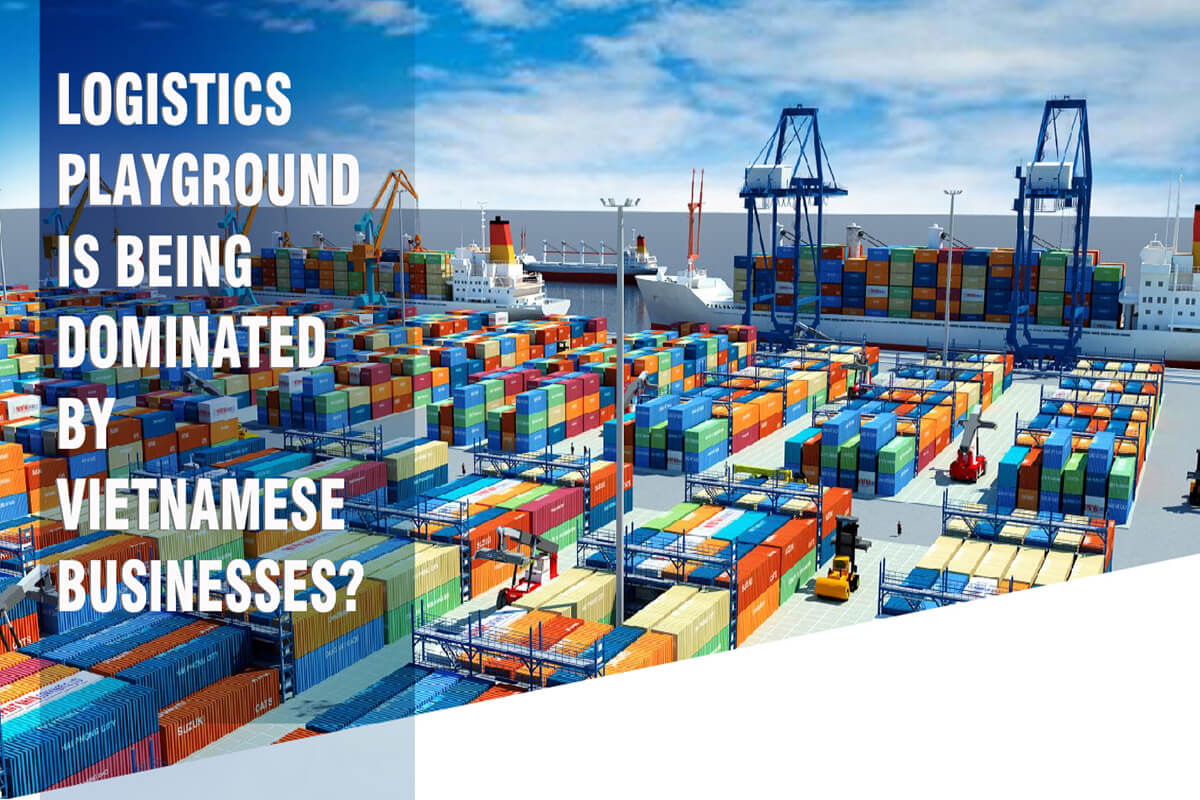
In recent years, Vietnamese logistics
businesses have made a big breakthrough and achieved dominant position in various sectors such as transportation, storage and port. Domestic firms’ major market shares indicate a sound investment and business strategy, create competiveness, and promote other sectors’ development.

WHEN DOMESTIC FIRMS DOMINATE “THE DOMESTIC MARKET”
![]()
According to Agency of Foreign Trade (Ministry of Industry and Trade), logistics sectors now have over 3,000 firms with a growth rate of 12-14% in 2018.

Le Duy Hiep, the President of Vietnam Logistics Association, stated that logistics sector have made a marked improvement clearly reflected in Global Competitiveness Index biennially analyzed by the World Bank. According to the latest results released by the World Bank in 2018, Vietnam ranked 39th out of 160 countries (increase by 25 levels).
People used to consider that foreign firms dominate the “logistics playground” because with merely 5% of the number of firms, they account for larger market shares. However, according to a recent survey by Vietnam Logistics Research and Development Institute (VLI), out of over 3,000 firms, domestic firms, joint venture firms, and direct foreign investment firms account for 88%, 10%, and 2% respectively. Domestic logistics firms are also the first choice of businesses with nearly 52.8%, which indicates their confidence in domestic logistics service providers. In particular, domestic firms are currently dominating most of areas such as port, storage, domestic road and waterway transportation. In terms of air and sea transportation, Vietnamese firms still show their limitation given the lack of large airways and experience in exploiting seaports and international orders, Mr. Hiep further analyzed.

Dominance in most of logistics areas has helped the sector grow more strongly by
substantially cutting down on the logistics costs. If logistics costs used to account for over 20% of GDP, Vietnamese logistics service market amounted to USD 10-11 billion and account for merely 17% of GDP in 2018.

SUPPORT BUSINESS AND EXPORTS
![]()
VAL assessed that complementary services have promptly met diverse requirements of logistics’ market. Improvements in the administrative procedures and business conditions of most of areas have promoted export, created comprehensive logistics supply chain from transportation, storage and port to packaging and warehouse.
Take delivery services for example, the strong growth of delivery firms such as
Giaohangnhanh.vn, Giaohangtietkiem… have forced traditional firms such as South Logistics JSC and Vietnam Post to adapt to change. Accordingly, these companies have diversified their services by enhancing customer services, lowering shipping fees and applying
technologies so that customer could track their packages.
With regards to seaport services, according to Agency of Foreign Trade (Ministry of Industry and Trade), there are now a total of 265 harbors/402 harbor bridges with a length of 87,550 meter and a capacity of about 5,00-550 million tons of goods per year. The majority of general ports and area hubs that are able to accept 30.000-50.000-DWT-and-over ships (Cai Mep – Thi Vai accepts 160,000-194,000-DWT ships facilitating growth of export companies.

For instance, Dong Nai Port have made various improvement in its operation. Mr. Nguyen Ngoc Tuan – General Director of Dong Nai Port JSC stated that PDN completed upgrading B3 harbor from 15.000 DWT to 30.000 DWT, and investing in new equipment at Go Dau Port to launch since 12/2018. Moreover, in November 2018, PDN held a launching ceremony to further expand by 50m bridging Deport no. 2 and Deport no. 3 at Long Binh Tan Port and expects to complete in April 2019. All are aimed at supporting transporting finished goods from warehouses to industrial zones in Dong Nai province and its vicinity.
Saigon Newport also stated that it would modernize its delivery and carriage procedures and process and apply the Industry 4.0’s achievements; enhance operational efficiency of Cat Lai Port, strengthen connection among ports in the network; promote cooperation with customers, partners and state authorities to offer the high quality service to export companies.
According to Vietnam Association of Seafood Exporters and Producers (VACEP) the sector has exported a total of USD 9 billion attributed to the positive improvement in domestic logistics from warehouse system to transportation that well meet the fishery firms’ demand.
OUTLOOK FOR 2019
![]()
Regarding to perspective of logistics in 2019, several firms find that the growth will amount to a two-digital figure, and no firms forecast “unchanged” or “worse” than 2018.
In terms of outlook, Mr. Le Duy Hiep stated that logistics legal framework and policies are gradually being completed. The Government issued the Decision No. 200/QĐ-TTg approving the action plan for improvement of competitiveness and development of Vietnam’s logistics services 708/QĐ-BCT approving plans for improvement of Vietnam’s logistics performance index (LPI). Currently, VLA is based on these Decisions to develop operational strategies, enhance human resource training and apply technologies to logistics management to improve the sector
competitiveness.
According to the Ministry of Industry and Trade, logistics infrastructure including logistics hub, delivery hub, inland container deport, bonded warehouse have all increased by number and been updated with current technology. Logistics hubs are shifting their focus on applying information technology to goods management, location tracking and detection. Some specialized logistics hubs become completely robotics. Big logistics hubs are now located in Hai Phong, Dong Nai and Binh Duong.




